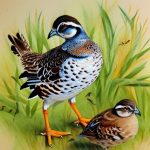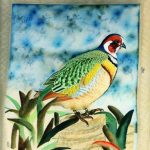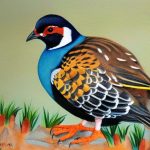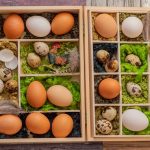Gambel quail, also known as desert quail, are popular game birds native to the southwestern United States. They are known for their striking plumage and distinctive topknot, making them a sought-after species for breeding and hunting enthusiasts. Breeding Gambel quail can be a rewarding and enjoyable experience for those interested in aviculture and conservation efforts. By understanding the breeding process and providing the proper care and environment, breeders can contribute to the preservation of this unique species.
Breeding Gambel quail requires careful consideration of breeding stock, environmental conditions, incubation processes, chick care, and health and nutrition. This article will provide a comprehensive guide to successfully breeding Gambel quail, from selecting breeding stock to caring for chicks and ensuring their overall health and well-being. With the right knowledge and dedication, breeders can play a vital role in the conservation and propagation of this beautiful species.
Table of Contents
- 1 Selecting Breeding Stock
- 2 Creating the Ideal Breeding Environment
- 3 Breeding and Incubation Process
- 4 Caring for Chicks
- 5 Health and Nutrition for Breeding Quail
- 6 Tips for Successful Gambel Quail Breeding
- 7 FAQs
- 7.1 What is the breeding season for Gambel quail?
- 7.2 How many eggs do Gambel quail typically lay?
- 7.3 What is the incubation period for Gambel quail eggs?
- 7.4 What is the best way to provide a suitable breeding environment for Gambel quail?
- 7.5 What are some common challenges in breeding Gambel quail?
Key Takeaways
- Gambel quail breeding requires careful selection of breeding stock to ensure healthy and productive offspring.
- Creating the ideal breeding environment involves providing adequate space, shelter, and nesting materials for the quail.
- The breeding and incubation process involves proper timing, temperature, and humidity control to ensure successful hatching.
- Caring for chicks involves providing a warm and safe brooding area, as well as a balanced diet and clean water.
- Health and nutrition for breeding quail are crucial for the overall success of the breeding program, including proper vaccinations and a well-balanced diet.
Selecting Breeding Stock
Selecting the right breeding stock is crucial for successful Gambel quail breeding. When choosing breeding birds, it is important to select healthy, disease-free adults with strong genetic traits. Look for birds that exhibit vibrant plumage, good body conformation, and a lively disposition. Avoid birds with deformities, injuries, or signs of illness, as these traits can be passed on to future generations.
It is also essential to maintain genetic diversity within the breeding stock to prevent inbreeding and maintain overall population health. Avoid breeding closely related birds and periodically introduce new bloodlines to the breeding program. This can be achieved by acquiring birds from reputable breeders or wildlife rehabilitation centers. Additionally, consider the birds’ reproductive history and select individuals that have demonstrated successful breeding behavior and fertility.
By carefully selecting breeding stock, breeders can ensure the production of healthy offspring with desirable traits, ultimately contributing to the long-term sustainability of the Gambel quail population.
Creating the Ideal Breeding Environment
Creating the ideal breeding environment is essential for the health and reproductive success of Gambel quail. Breeding enclosures should provide ample space for the birds to move freely and engage in natural behaviors such as dust bathing, foraging, and courtship displays. The enclosure should also offer protection from predators and the elements while allowing for adequate ventilation and natural light.
When designing a breeding environment, consider incorporating natural elements such as native vegetation, rocks, and branches to mimic the quail’s natural habitat. This can provide enrichment for the birds and encourage natural behaviors. Additionally, provide nesting boxes or shelters where the quail can lay eggs and rear their young in a secure and secluded space.
Maintaining a clean and hygienic environment is crucial for preventing disease and ensuring the overall well-being of the breeding birds. Regularly clean and disinfect the enclosure, provide fresh bedding material, and monitor for signs of stress or illness. By creating a suitable breeding environment, breeders can promote natural behaviors and reproductive success in their Gambel quail population.
Breeding and Incubation Process
The breeding and incubation process is a critical stage in Gambel quail breeding. Breeding pairs should be introduced to each other in the breeding enclosure during the spring months when quail are naturally inclined to breed. Monitor the birds for courtship behavior, such as male displays and vocalizations, which indicate that mating is taking place.
Once mating has occurred, females will begin laying eggs in the nesting boxes or shelters provided. It is essential to collect the eggs daily to prevent damage or predation and ensure proper incubation conditions. Eggs should be stored in a cool, humid environment until they are ready for incubation.
When incubating Gambel quail eggs, maintain a consistent temperature of around 100 degrees Fahrenheit and high humidity levels of 60-70%. Use a reliable incubator with automatic turning capabilities to simulate natural nest conditions. Monitor the development of the embryos closely and be prepared to intervene if any issues arise during incubation.
After approximately 23-24 days of incubation, the eggs will begin to hatch, and chicks will emerge. It is crucial to provide a warm, safe brooding area for the newly hatched chicks, equipped with heat lamps, bedding material, and access to food and water. By carefully managing the breeding and incubation process, breeders can maximize hatching success and ensure the health and vitality of the newborn chicks.
Caring for Chicks
Caring for newborn Gambel quail chicks requires attention to detail and a nurturing approach. Newly hatched chicks are fragile and vulnerable, requiring a warm and secure brooding area to thrive. Provide a brooder box with a heat source such as a heat lamp or heating pad to maintain a temperature of around 95 degrees Fahrenheit during the first week of life. Gradually reduce the temperature by 5 degrees each week until the chicks are fully feathered and able to regulate their body temperature.
Offer a high-quality game bird starter feed specifically formulated for young quail chicks to ensure proper nutrition and growth. Additionally, provide access to clean water at all times, using shallow dishes or specialized chick waterers to prevent drowning accidents.
Monitor the chicks closely for signs of illness or distress, such as lethargy, weakness, or abnormal behavior. Address any health concerns promptly by consulting with a veterinarian experienced in avian care. By providing attentive care and meeting the specific needs of newborn quail chicks, breeders can promote healthy development and ensure their overall well-being.
Health and Nutrition for Breeding Quail

Maintaining optimal health and nutrition is essential for breeding Gambel quail throughout their lifecycle. Provide a balanced diet consisting of high-quality game bird feed supplemented with fresh greens, seeds, insects, and grit to meet their nutritional requirements. Ensure access to clean water at all times, using specialized waterers designed to prevent contamination and spills.
Regularly monitor the health of breeding quail for signs of illness or disease, such as changes in appetite, behavior, or appearance. Implement a proactive healthcare program that includes regular wellness checks, parasite control, and vaccinations as recommended by an avian veterinarian.
Preventative measures such as biosecurity protocols, quarantine procedures for new birds, and regular cleaning and disinfection of enclosures can help minimize the risk of disease outbreaks within the breeding population. By prioritizing health and nutrition for breeding quail, breeders can support reproductive success and overall population vitality.
Tips for Successful Gambel Quail Breeding
Successful Gambel quail breeding requires attention to detail, dedication, and a thorough understanding of the species’ natural behaviors and requirements. Consider implementing the following tips to enhance breeding success:
1. Monitor breeding pairs closely for signs of compatibility and successful mating behavior.
2. Provide ample nesting boxes or shelters for females to lay eggs in a secure environment.
3. Maintain optimal environmental conditions within the breeding enclosure to promote natural behaviors and reproductive success.
4. Implement a proactive healthcare program that includes regular wellness checks and preventative measures against disease.
5. Offer a balanced diet consisting of high-quality game bird feed supplemented with fresh greens, seeds, insects, and grit to meet nutritional needs.
6. Provide attentive care for newborn chicks, including a warm brooding area, proper nutrition, and monitoring for signs of illness or distress.
7. Seek guidance from experienced breeders or avian professionals to enhance your knowledge of Gambel quail breeding practices.
By following these tips and best practices, breeders can contribute to the conservation efforts of Gambel quail while enjoying the rewards of successful breeding endeavors.
If you’re interested in breeding Gambel quail, you may also want to explore the world of poultry farming. Poultry Wizard offers a wealth of information on raising and caring for various types of poultry, including chickens. In their article “How Many Chickens Do You Need for a Family of 4?,” they provide valuable insights into determining the right number of chickens for your family’s needs. Additionally, their piece “The Chicken Coop Country Diner” offers creative ideas for designing a functional and attractive chicken coop. Whether you’re interested in quail or chickens, Poultry Wizard has resources to help you succeed in your poultry breeding endeavors.
FAQs
What is the breeding season for Gambel quail?
The breeding season for Gambel quail typically occurs from late April to early July.
How many eggs do Gambel quail typically lay?
Gambel quail typically lay around 12-16 eggs in a clutch.
What is the incubation period for Gambel quail eggs?
The incubation period for Gambel quail eggs is approximately 21-24 days.
What is the best way to provide a suitable breeding environment for Gambel quail?
To provide a suitable breeding environment for Gambel quail, it is important to have a spacious and secure enclosure with plenty of hiding spots and nesting areas. Additionally, providing a balanced diet and ensuring proper temperature and lighting conditions are essential for successful breeding.
What are some common challenges in breeding Gambel quail?
Common challenges in breeding Gambel quail include maintaining proper temperature and humidity levels during incubation, preventing egg infertility, and ensuring the health and safety of the chicks after hatching. Additionally, providing a balanced diet and minimizing stress in the breeding environment are important factors to consider.
Meet Walter, the feathered-friend fanatic of Florida! Nestled in the sunshine state, Walter struts through life with his feathered companions, clucking his way to happiness. With a coop that’s fancier than a five-star hotel, he’s the Don Juan of the chicken world. When he’s not teaching his hens to do the cha-cha, you’ll find him in a heated debate with his prized rooster, Sir Clucks-a-Lot. Walter’s poultry passion is no yolk; he’s the sunny-side-up guy you never knew you needed in your flock of friends!







